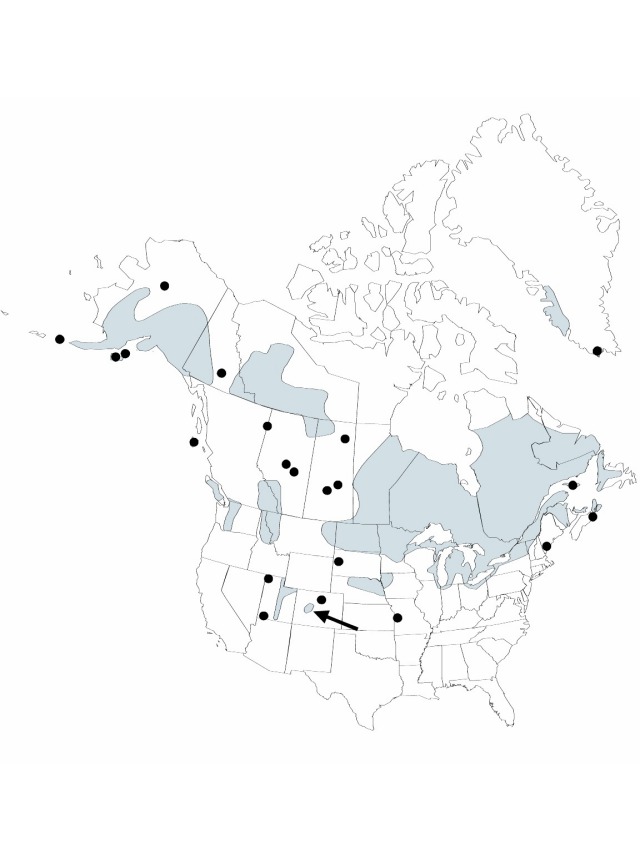Difference between revisions of "Juncus alpinoarticulatus"
in D. Villars, Hist. Pl. Dauphiné 1: 378. 1786.
GeoffLevin (talk | contribs) m (Removed extraneous periods after Juncus in synonymy) |
GeoffLevin (talk | contribs) m (Changed "alpinus" to "alpinoarticulatus" in discussion.) |
||
| Line 72: | Line 72: | ||
|elevation=0–2600 m | |elevation=0–2600 m | ||
|distribution=Greenland;;Alta.;B.C.;Man.;N.B.;Nfld. and Labr.;N.S.;N.W.T.;Ont.;P.E.I.;Que.;Sask.;Yukon;Alaska;Colo.;Idaho;Ill.;Ind.;Iowa;Maine;Mich.;Minn.;Mo.;Mont.;Nebr.;N.Y.;N.Dak.;Ohio;Pa.;S.Dak.;Utah;Vt.;Wash.;Wis.;Eurasia. | |distribution=Greenland;;Alta.;B.C.;Man.;N.B.;Nfld. and Labr.;N.S.;N.W.T.;Ont.;P.E.I.;Que.;Sask.;Yukon;Alaska;Colo.;Idaho;Ill.;Ind.;Iowa;Maine;Mich.;Minn.;Mo.;Mont.;Nebr.;N.Y.;N.Dak.;Ohio;Pa.;S.Dak.;Utah;Vt.;Wash.;Wis.;Eurasia. | ||
| − | |discussion=<p>Several attempts have been made to separate subspecies or varieties of this widespread and variable species. In one study, five varieties were recognized, with four in North America (B. Lindquist 1932) . In another, at least six subspecies were recognized with two in North America (L. Hämet-Ahti 1986). The variation we | + | |discussion=<p>Several attempts have been made to separate subspecies or varieties of this widespread and variable species. In one study, five varieties were recognized, with four in North America (B. Lindquist 1932) . In another, at least six subspecies were recognized with two in North America (L. Hämet-Ahti 1986). The variation we have encountered does not fit nicely into the subspecies Hämet-Ahti has recognized, and until a full account of the variation throughout the range of the species is presented, we are not recognizing subspecific or varietal divisions of this species. Recent evidence suggests that this species may be one of the parents of the tetraploid <i>Juncus articulatus</i>. <i>Juncus alpinoarticulatus</i> hybridizes with <i>J. brevicaudatus</i> (= J. × gracilescens J. Hermann), <i>J. articulatus</i> (= J. × alpiniformis Fernald), <i>J. nodosus</i> (= J. × nodosiformis Fernald), and <i>J. torreyi</i> (= J. ×stuckeyi Reinking).</p> |
|tables= | |tables= | ||
|references= | |references= | ||
Revision as of 18:20, 3 June 2022
Herbs, perennial, rhizomatous, 0.5–5 dm. Rhizomes 2–4 mm diam., not swollen. Culms erect, terete, 1–3 mm diam., smooth. Cataphylls 0–1, straw-colored or maroon, apex acute. Leaves: basal 0–2, cauline 1–2(–5); auricles 0.5–1.2 mm, apex rounded, scarious; blade green to straw-colored, terete, 1.5–12 cm × 0.5–1.1 mm. Inflorescences terminal panicles of 5–25 heads, 3–11 cm, branches erect to ascending; primary bract erect; heads 2–10-flowered, obpyramidal, usually with some flowers short- pedicellateled, 2–6 mm in diam. Flowers: tepals greenish to straw-colored, lanceolate to oblong; outer tepals 1.8–3 mm, apex obtuse, mucronate; inner tepals 1.6–2.7 mm, apex obtuse; stamens 6, anthers 1/2 filament length. Capsules equaling perianth to usually exserted, chestnut brown to straw-colored, imperfectly 3-locular, oblong to oblong-ovoid, 2.3–3.5 mm, apex obtuse, valves separating at dehiscence. Seeds oblong to ovoid, 0.5–0.7 mm, not tailed. 2n = 40.
Phenology: Fruiting mid summer–fall.
Habitat: Wet meadows, sandy and gravelly, often calcareous shores, fens, and clayey pools over rock
Elevation: 0–2600 m
Distribution

Greenland, Alta., B.C., Man., N.B., Nfld. and Labr., N.S., N.W.T., Ont., P.E.I., Que., Sask., Yukon, Alaska, Colo., Idaho, Ill., Ind., Iowa, Maine, Mich., Minn., Mo., Mont., Nebr., N.Y., N.Dak., Ohio, Pa., S.Dak., Utah, Vt., Wash., Wis., Eurasia.
Discussion
Several attempts have been made to separate subspecies or varieties of this widespread and variable species. In one study, five varieties were recognized, with four in North America (B. Lindquist 1932) . In another, at least six subspecies were recognized with two in North America (L. Hämet-Ahti 1986). The variation we have encountered does not fit nicely into the subspecies Hämet-Ahti has recognized, and until a full account of the variation throughout the range of the species is presented, we are not recognizing subspecific or varietal divisions of this species. Recent evidence suggests that this species may be one of the parents of the tetraploid Juncus articulatus. Juncus alpinoarticulatus hybridizes with J. brevicaudatus (= J. × gracilescens J. Hermann), J. articulatus (= J. × alpiniformis Fernald), J. nodosus (= J. × nodosiformis Fernald), and J. torreyi (= J. ×stuckeyi Reinking).
Selected References
None.